Tan Girl Green Clothes White Girl Blue Dress Lesbians
While most of us are now familiar with the famous LGBT rainbow flag representing queer pride, many of us are not aware that it is different from the original rainbow Gay Pride Flag designed by Gilbert Baker. Nor that there are now more inclusive versions that specifically recognize the trans, intersex, and POCs in our diverse community.
And when we are talking about the different LGBTQ Flags and their meanings, there is far more than just this one flag.
In fact, there are now over 50 flags recognized among the LGBTQ+ community, each used to symbolize different gender identities and sexual orientations within. While most queer individuals would also identify with the all-encompassing rainbow flag, many want to have their own individual flag.

Imagine the rainbow flag is the US flag, and many of these other flags are like individual states underneath. In a community as large and beautifully diverse as ours, it is natural that smaller tribes will want to carve out some recognition for themselves; thus, the different LGBTQ Flags we have today.
As Gilbert Baker, the original creator of the first rainbow Gay Pride Flag, said, "Flags say something. You put a rainbow flag on your windshield, and you're saying something."
So, what do these different LGBTQ Flags say? Well, we have rounded them up and tried our best to explain the meaning behind them all. There is some contention of meaning, or it has been lost to time – but our explanations should still help give some context.
So, let us introduce the different LGBTQ Flags and their meanings…
In this article we will cover...
- Abrosexual Pride Flag
- Agender Pride Flag
- Androgyne Pride Flag
- Aromantic Pride Flag
- Asexual Pride Flag
- Bigender Pride Flag
- Bisexual Pride Flag
- Butch Lesbian Flag
- Demiboy Pride Flag
- Demigender Pride Flag
- Demigirl Pride Flag
- Demisexual Pride Flag
- Drag Feather Pride Flag
- Drag Pride Flag
- Gay Bear Brotherhood Pride Flag
- Gay Leather Pride Flag
- Gay Men's Pride Flag
- Genderfluid Pride Flag
- Genderflux Pride Flag
- Genderqueer Pride Flag
- Graysexual Pride Flag
- Hijra Flag
- Intersex Pride Flag
- LGBT Rainbow Pride Flag
- LGBT Progress Pride Flag
- LGBT Progress Pride (Intersex- Inclusive) Flag
- Labrys Lesbian Pride Flag
- Lesbian Pride Flag
- Lipstick Lesbian Pride Flag
- Maverique Pride Flag
- Neutrois Pride Flag
- Non-Binary Pride Flag
- Omnisexual Pride Flag
- Original Gilbert Baker Rainbow Pride Flag
- Pangender Pride Flag
- Pansexual Pride Flag
- Philadelphia Pride Flag
- Polyamory Pride Flag
- Polysexual Pride Flag
- Puppy Pride Flag
- Queer Pride Flag
- Questioning Pride Flag
- Rubber Pride Flag
- Straight Ally Pride Flag
- Transgender Pride Flag
- Trigender Pride Flag
- Twink Pride Flag
- Two-Spirit Pride Flag
- Other Popular LGBTQ Flags
- Born This Way Pride Flag
- Canada Gay Pride Flag
- Equal Human Rights Pride Flag
- Equality for Everyone Pride Flag
- Gay Pride Peace Flag
- HUMAN LGBT Pride Flag
- Kindness Is Everything Pride Flag
- LGBT Pride Flag
- USA Gay Pride Flag
Abrosexual Pride Flag
An abrosexual person has a fluid sexual orientation and may experience different sexual orientations over time. They may be one sexuality today and be another tomorrow. The timeframe to change an abrosexual individuals' sexual orientation doesn't matter, and it could be hours or years before they identify as different sexuality.
The abrosexual flag was created by Mod Chad of pride flags-for-us after an anonymous Tumblr user requested it. It is also thought that the flag and the term originated on DeviantArt in 2013 and later gained recognition on Tumblr.
The abrosexual flag is made up of five colors. There's dark green, light green, white, baby pink, and rich pink from top to bottom. It isn't known why these colors were specifically chosen for the abrosexual flag. One Tumblr user on the page abrosexual learning shared their interpretation of what the flag's colors mean.
They said, "Green represents a queer attraction, the fade to white is for the in-between stage of attraction shifting, and pink is for the actual shift itself. Also, the colors match that of watermelon, which could be a fun pun on the /fluidity/ of our orientation."
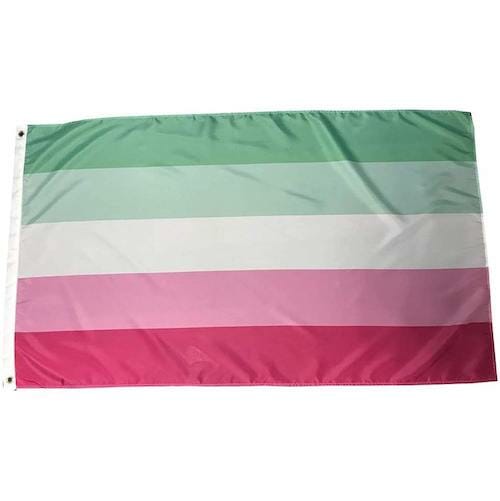
Agender Pride Flag
Agender refers to a person who does not identify themselves as having a particular gender. Other words used to describe agender include genderfree, neutrois, gender blank, or genderless.
The agender pride flag was created in 2014 by Salem X. It has seven equal-sized horizontal stripes. The stripes are colored black, gray, and white, with a central green one, then the opposite white, gray, and black to finish.
The agender flag has four colors. Here's what they all mean:
- Black and white stripes represent a lack of gender
- Gray represents semi-genderless
- Green represents nonbinary genders.
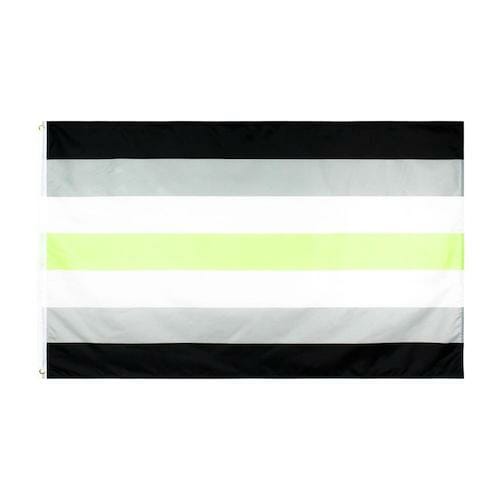
Androgyne Pride Flag
An androgynous person is someone who displays a combination of masculine and feminine characteristics into an ambiguous form. Androgyny may be stated with respect to biological sex, gender identity, and/or gender expression.
The androgyne flag includes three vertical stripes, and on July 24th, 2014, Tumblr user saveferris made the flag. There are three colors on the flag:
- Pink which represents femininity and womanhood.
- Blue which represents masculinity and manhood.
- Purple which represents androgyny, which is a combination of the two colors.

Aromantic Pride Flag
Aromantics have no interest in or desire for romantic relationships and have been represented by three flags in the past few years. The first one had four stripes with orange, green, black, and yellow. On this flag, green is the opposite of romance, yellow is for friendship, orange is for aromantics, and black is for alloromantics who don't subscribe to the traditional boundaries of romance.
It isn't known who created this flag or when.
The next aromantic pride flag had five stripes. The colors were black, grey, yellow, light green, and dark green. Like many LGBTQ flags, this one was first created on Tumblr (in 2014 by user Cameron). The third design is the most recent one and is currently the most widely used and accepted version of the aromantic pride flag. Cameron also designed this flag on November 16th, 2014.
The aromantic flag has four colors. Here's what they all mean:
- Dark green represents aromanticism.
- Light green represents the aromantic spectrum.
- White represents aesthetic attraction and queer/quasi platonic relationships.
- Grey represents demiromantic and grey-aromantic people.
- Black represents the sexuality spectrum.
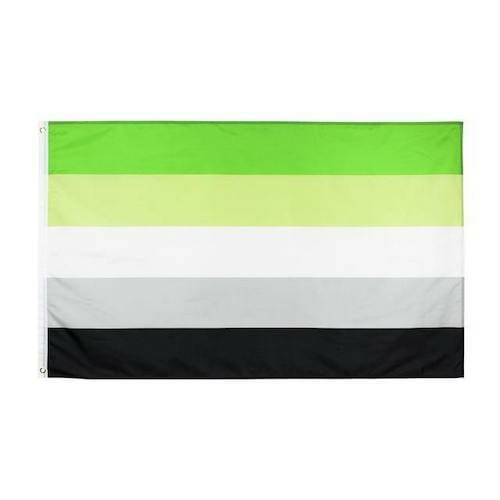
Asexual Pride Flag
An asexual person is someone who has no sexual feelings or desires or who is not sexually attracted to anyone.
Asexual visibility and education network (AVEN) user standup designed the asexuality flag in 2010. It was chosen as the result of a month-long competition on the message boards to find an ace flag. The movement to create a flag traversed multiple threads and had three distinct polling stages.
In an endeavor to incorporate aces outside the forum, polling in the final vote was expanded to other ace communities, including non-English forums. This was a successful move as it is now widely used around the world.
The asexual pride flag is a simple four-bar design that cleverly avoids references to special symbols like hearts or triangles. The asexuality flag also doesn't reference any nation and fits with the designs of other Gender and Sexual Minority (GSM) community pride flags.
The asexuality flag has four colors. Here's what they all mean:
- Purple represents community.
- White represents non- asexual allies and partners.
- Grey represents demisexuality and grey-asexuality.
- Black represents asexuality.
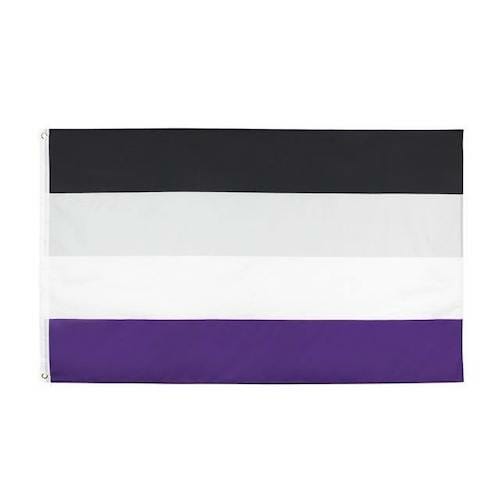
Bigender Pride Flag
A bigender person is some whose sense of personal identity encompasses two genders. It literally translates as 'two genders' or 'double gender,' and these genders could be male and female but could also combine non-binary identities.
There are many widely used bigender flags – more than most LGBTQ+ identities – which is largely due to accusations around transphobia (among other things) of the original flag creator. We will discuss the second most common bigender flag, by camp-MLM, but if you are planning to fly one or get one as a gift for a friend, you might want to investigate the numerous alternatives. It has seven stripes, and the colors are thought to mean:
- Pink/blue stripes are for presentation and the feeling of your identities (feminine, masculine, androgynous, whatever suits you).
- The top purple is for all kinds of good relationships.
- The white is for your unique bigender experience, how it feels and what it's like. It's also for understanding each other in this community!
- The bottom purple is about self-respect, pride, and being true to yourself.
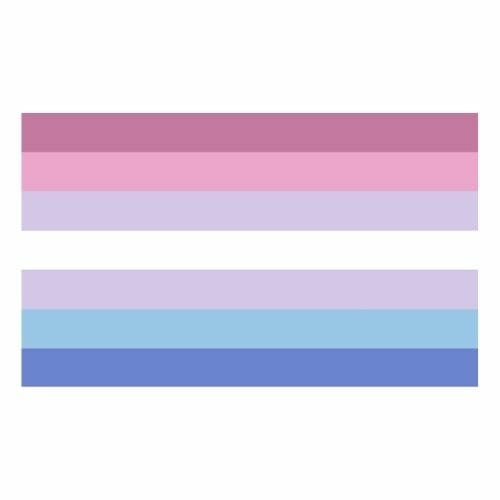
Bisexual Pride Flag
A bisexual person is someone who is sexually attracted to both men and women. Bisexuality may also be interpreted as a person with romantic or sexual attraction to people regardless of their sex or gender identity, how this is known more specifically as pansexuality.
Michael Page designed the bisexual pride flag in 1998 to give the bisexual community a symbol that was comparable to the gay pride rainbow flag. He aimed to increase visibility towards the bisexual community, because bi-erasure is a real thing – and is arguable just as big a problem then as it is now.
The bisexual flag has three colors. Here's what they all mean:
- Pink represents same-gender attraction.
- Blue represents sexual attraction to the opposite gender. In the case of non-binary genders, it refers to sexual attraction to a different gender.
- Purple (the overlap between pink and blue) represents sexual attraction to two or more genders.
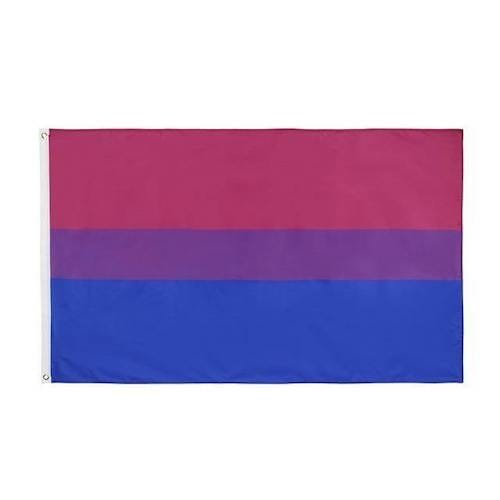
Butch Lesbian Flag
In lesbian culture, the word 'butch' indicates a woman whose gender expression and traits present as typically 'masculine'. Being butch is about playing with and questioning traditional binary male and female gender roles and expressions.
Tumbler user Dorian—rutherford produced the first butch lesbian pride flag in 2016 using shades of blues and purple. The flag was created for lesbians who do not identify with the lipstick lesbian flag, which has strong feminine overtones. The original tumbler post was removed; however, it later reappeared on deviantart.com.
Butchspace, a tumbler user, devised a new form of the butch flag in 2017 to symbolize butch pride using shades of orange. Both butch lesbian flag versions are still gaining popularity in the community – and much like the lesbian pride flags, there is no clear preferred option.
People have speculated that the blue signifies masculinity, the purple represents lesbian and woman-identified folks, and the white represents people across the gender and sexuality spectrums more widely, despite the fact that the artist never clearly stated the significance of the colors. A similar explanation and problem exist for the orange butch flag.
As both butch lesbian flags are in almost equal use, we simply suggest flying the version that you most like.
Demiboy Pride Flag
A demiboy (sometimes known as a demiguy, demiman, demimale, or demidude person) is a person who identifies with aspects of masculinity—regardless of their sex assigned at birth.
Tumblr user Transrants designed the demiboy flag in 2015. However, he didn't explicitly explain the meaning behind the flag. However, since then, the community has lovingly adopted this flag, and the demiboys who now identify with it have assigned some meaning to it.
The demiboy flag has three colors. Here's what they are thought to mean:
- Blue represents manhood or masculinity.
- White represents non-binary or agender identities.
- Grey represents the grey areas and partial connections and the possibility of more genders rather than the two on the binary spectrum.
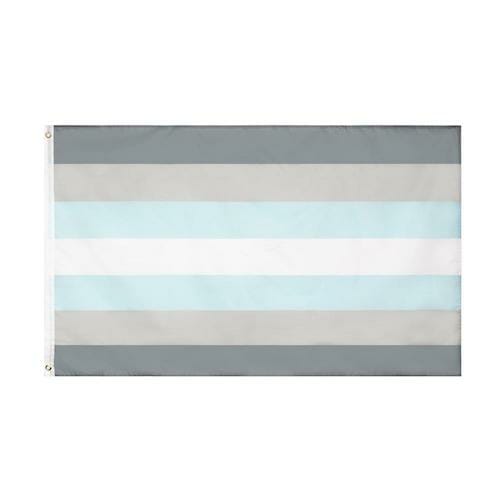
Demigender Pride Flag
A demigender (from demi "half" + "gender") is an umbrella term for nonbinary gender identities and denotes individuals who feel only a partial connection to a particular gender identity. The term covers demiboy and demigirl, along with a variety of other demi-gender identities.
While many demigender individuals prefer to fly their specific flag, there is an overarching demigender pride flag with seven stripes and dark grey, light grey, light yellow, white, light yellow, light grey, and dark grey coloration.
The 'demi-flags' greys symbolize fragmentary connections and grey regions, while the yellow signifies non-binary gender identities and the white signifies agender identification.
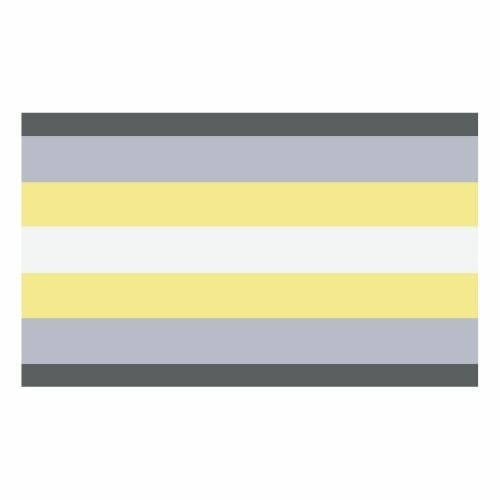
Demigirl Pride Flag
A demigirl (sometimes known as a demiwoman, demilady, or a demifemale person) is a person who identifies with aspects of femininity—regardless of their sex assigned at birth.
The demigirl flag was designed by Tumblr user Transrants in July 2015, and like the demiboy flag, there are no confirmed color meanings, but there are some common assumptions.
The demigirl pride flag is meant to represent gender neutrality, which is a massive factor in the experience of being a demigirl. It is intended to signify the feeling of questioning and shifting of gender.
The demigirl flag has three colors. Here's what they are thought to mean:
- Pink represents womanhood or femininity.
- White represents non-binary or agender identities.
- Grey represents the grey areas and partial connections and the possibility of more genders rather than the two on the binary spectrum.
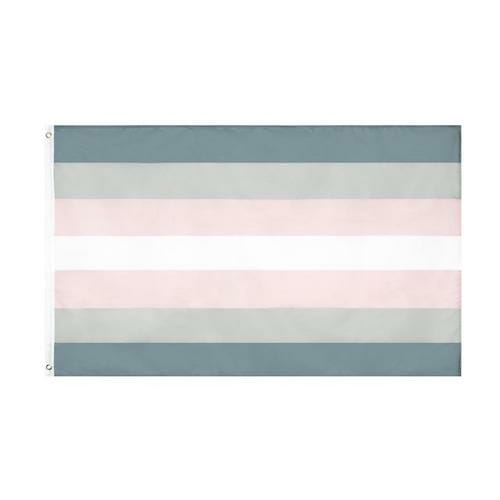
Demisexual Pride Flag
A demisexual is someone who only experiences sexual attraction to people with whom they have close emotional connections. For demisexuals, sexual attraction can only come after an emotional bond has formed.
Sadly, like many LGBTQ+ flags invented in the internet era, it is unknown when or by who the demisexual flag was created, but we can assume it was created after the asexual pride flag (created in 2010) as it uses the same colors.
The demisexual pride flag has a black triangle coming out of its left side. It has a thick white line on the top, followed by a thin purple one in the middle, then a thick gray one at the bottom.
The Demisexual flag is a symbol for those who are only sexually attracted to those they have a strong emotional connection to. The demisexual flag has three colors. Here's what they all mean:
- Black represents asexuality.
- Gray represents demisexuality.
- White represents sexuality.
- Purple represents community.
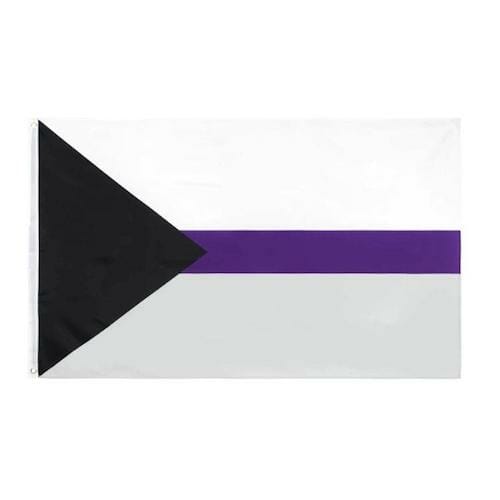
Drag Feather Pride Flag
The term "drag" suggests a performance of masculinity, femininity, or other forms of gender expression. To 'do drag' is to dress up or exhibit yourself differently than your everyday expression, usually for performance. Common forms of drag are drag queens and drag kings.
There are two drag pride flags; however, many drag entertainers are unaware of the earliest pride flag, which was created by artist Sean Campbell in 1999 and was called the Feather Pride Flag. It has a phoenix in its center which symbolizes rebirth and fires of passion with which the drag community exercises to raise awareness and funds in their communities.
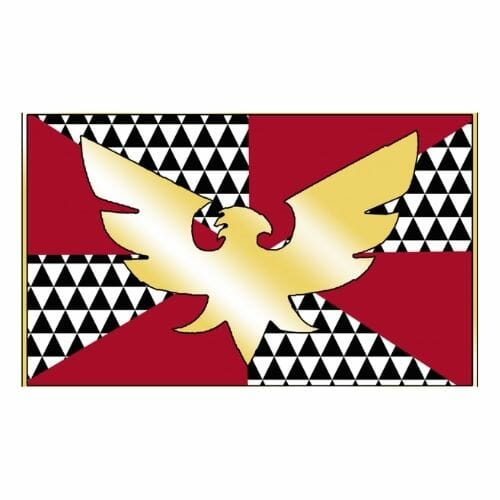
Drag Pride Flag
The second and now more commonly used Drag Pride flag resulted from the Austin International Drag Festival (AIDF) 2016. It has a crown and stars along with three vertical stripes. Thankfully we also know what the drag pride flag colours mean:
- Purple signifies a passion for drag.
- White signifies how one's body and face become a blank slate to change and create characters on.
- Blue signifies self-expression and loyalty.
- The crown signifies leadership within the community.
- The stars signify the many forms of drag.

Gay Bear Brotherhood Pride Flag
In gay culture, a bear is a larger and often hairier man who projects an image of rugged masculinity. Secondary sex attributes such as the growth of body hair and facial hair (which are typically considered "bear" characteristics) are celebrated in gay bear culture.
The International Bear Brotherhood Flag was created to represent the Brotherhood of Bears and was designed by Craig Byrnes in 1995. His undergraduate degree in psychology involved devising a senior project about the bear culture that had raged since the early 1980s, of which he had first-hand experience – and this flag results from this project.
The flag's colors are intended to represent the colors of animal bear furs from throughout the world, not necessarily human skin and hair color tones. Dark brown, orange/rust, golden yellow, tan, white, grey, and black are some of the colors included on the flag – along with a bear paw print.
The flag was created with the idea of inclusivity in mind – as the bear community is one of the most inclusive queer tribes there are!

Gay Leather Pride Flag
Since the 1990s, the leather subculture has utilized the leather pride flag as a symbol. Tony DeBlase developed it, and the homosexual leather scene rapidly accepted it. Since then, it's been connected with leather in general, as well as allied communities like the BDSM community.
On May 28th, 1989, he debuted the design at International Mister Leather. The flag is made up of nine equal-width horizontal stripes. The stripes change between black and royal blue from top to bottom. White is the middle stripe. A huge red heart appears in the upper left quadrant of the flag. His stated intention was to let the spectator decide how to interpret the colors and symbols.
Despite its popularity in the gay leather scene, the flag is not just a gay symbol; it symbolizes the whole leather community.
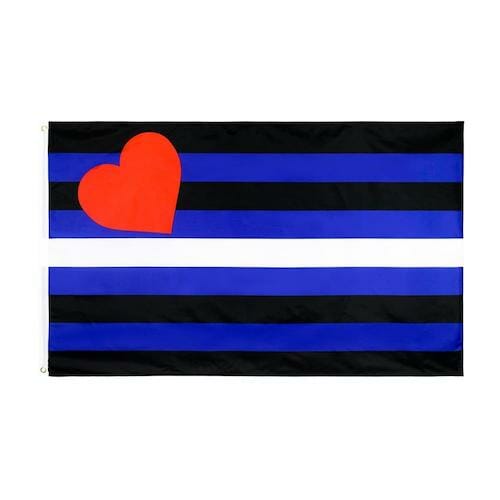
Gay Men's Pride Flag
Another lesser-known pride flag is the gay men's pride flag. It comes in a variety of green, blue, and purple hues.
This modern gay men's pride flag is a reimagining of a previous gay men's pride flag with a variety of blue tones. Because it employed colors that were stereotypical of the gender binary, that edition was problematic This new flag includes a broader spectrum of LGBT men, including transgender, intersex, and gender-nonconforming males, among others.
However, it is fair to say that most gay men prefer to simply use an iteration of the rainbow LGBTQ+ flag that is more representative of the entire queer community.

Genderfluid Pride Flag
Simply put, a genderfluid person is someone who does not identify themselves as having a fixed gender.
Genderfluid people experience gender fluctuations over time. For some genderfluid individuals, gender changes are arbitrary, while for some, they're extreme. Gender fluctuations may happen slowly over a period of months or years, or they may happen fast in a matter of hours or days.
The Genderfluid Pride Flag was created in 2012 by JJ Poole(they/them), an agender pansexual from New York state who advocates for people who do not fit into heteronormative society. They designed it to encompass all gender identities, and as such, the genderfluid flag has five horizontal stripes and five colors. The colors are:
- Pink for femininity.
- Blue for masculinity.
- Purple for femininity and masculinity.
- Black for lack of gender.
- White for all genders.
In 2021, LGBTA wiki user FruitIndividual designed an alternate genderfluid flag that represented the fluidity and change experienced by persons with this identity in the wave pattern of lines. It is quickly catching on and may soon be the preferred genderfluid flag.
White symbolizes ambiguous and/or non-binary identities, whereas lighter blue represents masculine identities, pink represents feminine identities, purple represents a combination of masculine and feminine identities, and purple represents a blend of masculine and feminine identities. The fluidity and change experienced by persons with this identity are represented by the wave pattern of the lines.
Genderflux Pride Flag
Genderflux is a catch-all phrase for gender identities in which one's gender or sense of the intensity of one's gender changes over time. A person who is genderflux experiences a range of intensity within a gender identity.
It is unknown who created the genderflux pride flag, and there are now three new versions; however, the original is most commonly used. It has six strips and six colors. The colors are thought to mean:
- Dark pink represents women.
- Light pink represents demigirls.
- Grey represents agender.
- Light blue represents demiboys.
- Dark blue represents men.
- Yellow represents non-binary genders.
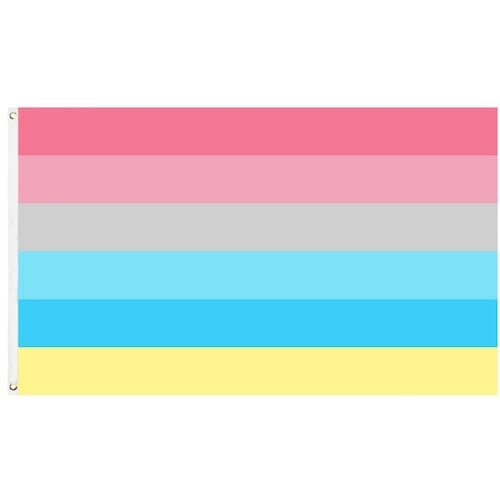
Genderqueer Pride Flag
A genderqueer person does not subscribe to conventional gender distinctions but still identifies with neither, both, or a combination of male and female genders. The term genderqueer is similar to nonbinary, but has a slightly different meaning and is best considered an umbrella term to cover any identity that isn't cisgender.
Marilyn Roxie, an advocate, and genderqueer writer, designed the genderqueer pride flag in 2011. The flag has three colors and three stripes. Here's what the colored stripes of the genderqueer flag mean:
- Lavender, created from a mix of pink and blue, which have traditionally stood for men and women, expresses queer identities and androgyny.
- White represents gender-neutral and agender identities.
- Chartreuse represents identities that aren't in the gender binary as well as the third gender.
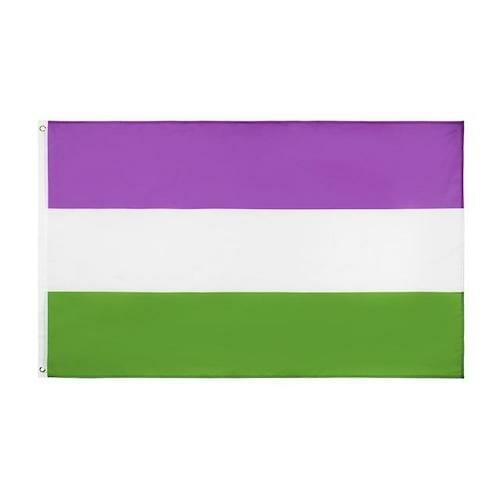
Graysexual Pride Flag
Graysexuality, also known as grey asexuality, gray-a, gray-ace, or grey-ace, is a word used to describe persons who identify as asexual but do not fall into one of the primary kinds of asexuality. Typically it is a person who experiences limited sexual attraction.
Milith Rusignuolo devised the first greysexual flag, which was uploaded to Wikipedia on June 21st, 2013. It was intended to represent someone starting with no sexual attraction (purple signifying asexuality), then going through a single episode of attraction (grey to white) with white indicating allosexuality from the asexual flag, and then returning to asexuality.
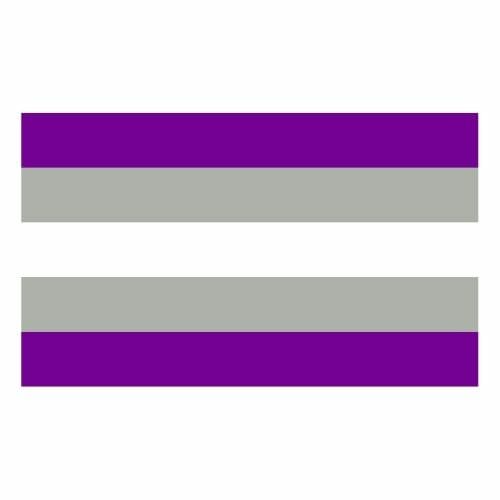
Hijra Flag
In India, the hijra is a formalized third gender status. As worshippers of the Mother Goddess Bahuchara Mata, their divine abilities are dependent on their asexuality.
These identities do not have a perfect counterpart in the gender and sexual orientation taxonomy, and they provide a challenge to Western notions of sex and gender. In India, some Hijras describe themselves not by their sexual orientation but by their complete lack of sexuality and tell how sacred powers are created by transforming sexual energy.
A person with the username HijrAnon produced the first known hijra flag in 2016. The symbolism of the flag was described by HijrAnon as follows:
- The pinkish background is meant to be ambiguous, looking like a pink or dark red depending on how you look at it
- The head shape with one-half white and one-half greenish is meant to represent Ardhanarishvara (the white half is Lord Shiva, the green half is Parvati, the light green middle is Ardhanarishvara themselves).
- The yellow ring near their neck is meant to be a necklace. In India, necklaces are usually worn for protection and good luck – so in a way, they wanted this to represent protection for hijras.
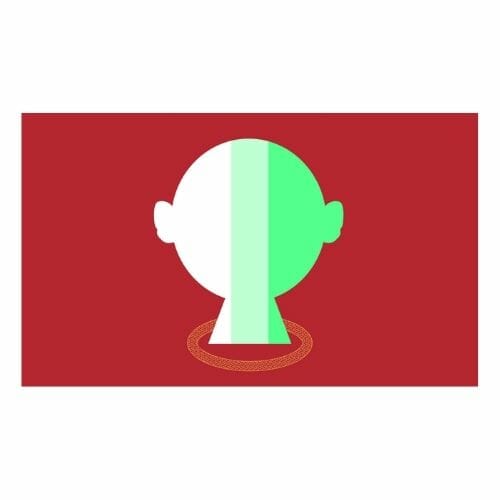
Intersex Pride Flag
Intersex is a term that may be used to describe a person with both male and female sex characteristics at birth. Many individuals born have several sex characteristics, including chromosome patterns, gonads, or genitals that, according to the Office of the United Nations High Commissioner for Human Rights, "do not fit typical binary notions of male or female bodies."
It is estimated that around 1.7% of the population is born with intersex traits – analogous to the number of people born with red hair. Notwithstanding how common this is, the word intersex is still generally misunderstood, and intersex people are massively underrepresented.
The most commonly used intersex pride flag is designed with a yellow background and a purple circle at the center. In 2013 Morgan Carpenter of Intersex Human Rights Australia chose yellow and purple to represent the intersex flag because none of these colors represent the traditional constructs of binary identities (male and female).
The circle is the intersex flag is also described by Morgan as "unbroken and unornamented, symbolizing wholeness and completeness, and our potentialities. We are still fighting for bodily autonomy and genital integrity, and this symbolizes the right to be who and how we want to be". It is not used, as often thought, to represent the differences in sexual and gender identities that members of the community experience.
However, it is important to note that not all members of the intersex community have embraced this intersex flag. Some of them will not identify with what it represents. As a result, there have been many changes to the intersex flag over the years, with many other flags being used concurrently. However, this is the most widely recognized.
We just love how the circle at the center of the intersex flag reminds us that intersex people are whole and that intersex people are perfect the way they choose to be, regardless of pseudoscientific claims or social norms.
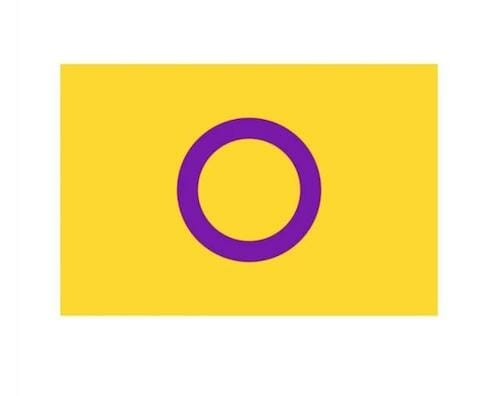
LGBT Rainbow Pride Flag
The LGBT rainbow flag represents lesbian, gay, bisexual, transgender, and queer (LGBT) and queer pride, as well as LGBT social movements. The colors of the LGBT pride flag, also known as the gay pride flag or LGBT pride flag, depict the LGBT community's variety as well as the "spectrum" of human sexuality and gender.
Based on the original Gilbert Baker Pride Flag (but with two fewer stripes), this is the most commonly seen LGBT flag in the world and is the most universally recognized.
The flag is most commonly flown horizontally, with the red stripe on top, as in a real rainbow.
Rainbow flags, as well as a variety of rainbow-themed merchandise and color schemes, are now used by LGBT people and supporters as an outward representation of their identification or support.
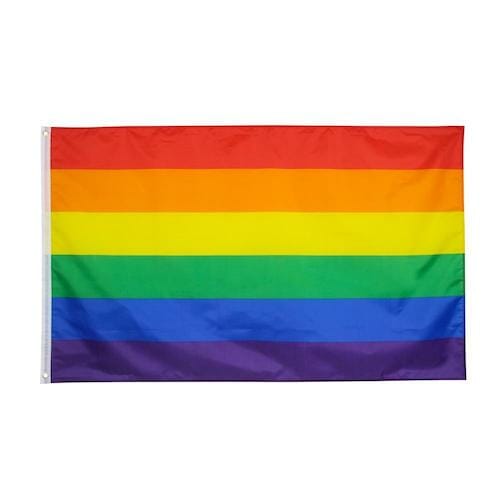
LGBT Progress Pride Flag
For the last 40+ years, the iconic LGBT Pride flag produced by Gilbert Baker' with its six distinguished colors (red, orange, yellow, green, blue, and violet) has been the globally recognized symbol of the LGBT community.
But in the past few years, Pride festivals, companies, and activists worldwide have concurrently and without any coordination been embracing 'The Progress Flag' as their emblem for the queer community instead.
Created by Daniel Quasar in 2018, the Pride Progress Flag features black and brown stripes to portray marginalized LGBTQ+ communities of color and baby blue, pink and white to incorporate the trans flag in its design.
Daniel displaced the trans flag stripes and marginalized community stripes to the flag's hoist, where they form a new arrow shape. The arrow leads to the right to confer forward movement while purposely being along the left edge, pointing to the fact that much progress still needs to be made.
From the London Mayor's office to Fort Lauderdale Pride and various cultural institutions worldwide–the symbol being used to serve LGBT people is evolving. And it's all part of a journey to be more inclusive of the expansive breadth of identities within our community.
The intention behind this change is not to replace or erase what the Pride flag was, but rather to recognize the value of all parts of our modern queer community, which the Progress flag does a better job of.
And considering the current Black Lives Matter movement and specifically the focus on issues faced by queer trans people of color (QTPOC) with our community – this shift towards the use of the more inclusive Pride Progress symbol is one should all fully support and encourage.
Hopefully, in doing so, we can start or continue a conversation not only about trans and POC representation within our community–but about bisexual, pansexual, and asexual people. And the progress that is still to come for the fabulous expanse of gender identities, romantic and sexual orientations we don't talk about enough yet.
The significance behind the Pride Progresses flag's design is an excellent encapsulation of where the LGBT community stands. We are a community that has, and is, making exceptional progress. And yet, we still have so much more to do!
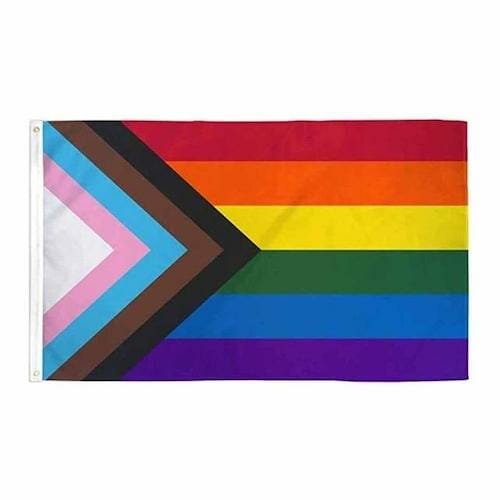
LGBT Progress Pride (Intersex- Inclusive) Flag
The ever-changing Pride symbol has been revised again, and in 2021 designed by Daniel Quasar was updated to be even more inclusive – specifically of the intersex community.
The latest version was created by intersex journalist and media figure Valentino Vecchietti. Intersex Equality Rights UK, an advocacy group, unveiled the flag in late May of 2021, and it has since gone viral on social media.
In Vecchietti's version, a purple circle overlaid over a yellow triangle has been added to the chevron on the left side of Quasar's design, a nod to Australian Morgan Carpenter's famous 2013 intersex flag.
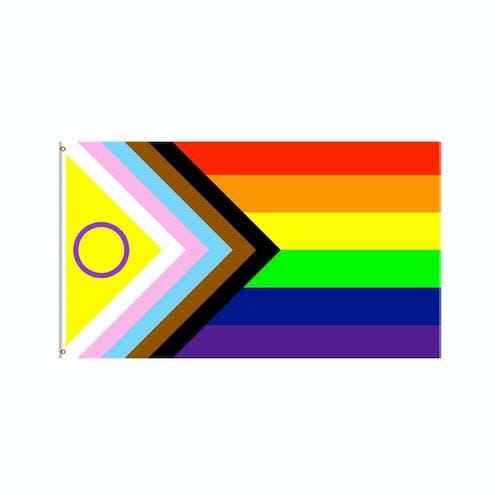
Labrys Lesbian Pride Flag
The labrys lesbian flag was designed in 1999 by graphic designer Sean Campbell, a cisgender gay man, and distributed in June 2000 in the Palm Springs edition of the Gay and Lesbian Times Pride issue.
The design includes a labrys, a double-headed ax, placed over an inverted black triangle, set against a violet background. Among its many meanings, the labrys was the weapon of choice for the Amazons of Greek mythology, a group of female warriors and hunters whose society was closed to men. It has been a symbol of empowerment used by lesbian feminists since the 1970s.
The inverted black triangle was the symbol worn by women considered asocial by the Third Reich (including homosexual females). They were condemned to concentration camps, similar to the pink triangle assigned to gay men. As gay men have reclaimed their symbol, many lesbians have also reclaimed this.
The symbol on the labrys lesbian flag has set on the color violet, which has been associated with lesbians via the poetry of Sappho.
This flag is not widely used now, possibly because a lesbian did not create it – but also because of concerns of its imagery rooted in the Holocaust. It is frequently used by trans-exclusionary lesbians or trans-exclusionary feminists, partly due to the Amazon's mythology where the women would either kill their sons or return them to their fathers, with whom they would only socialize briefly in order to reproduce.
As such, many lesbians today seek out a flag that is inclusive of trans women and the wider LGBT community.
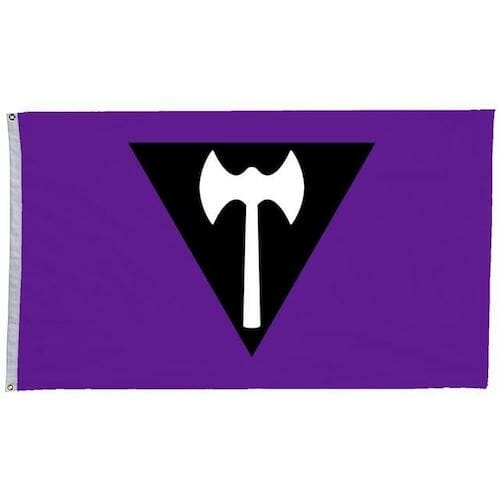
Lesbian Pride Flag
A lesbian is someone who experiences sexual or romantic attraction to other women or between women. The term normally applies to women; however, some nonbinary people also identify with this term.
The original Labrys lesbian flag was created in 1999, but it bears no resemblance to the current flag iterations. The first 'modern' lesbian flag was designed in 2010 – the lipstick lesbian flag, which had six shades of pink and red stripes, one white one in the middle, and a red kiss printed on them.
This flag was then changed by removing the kiss and attracted more use as a general lesbian pride flag. However, even this pink lesbian flag has been accused of not representing lesbians who do not align with femininity and is even viewed as offensive by some.
As a result, in 2018, a different 'orange-pink' lesbian pride flag was proposed as the new "lesbian flag for everyone" by Tumblr blogger Emily Gwen. The new flag has different colors which are said to stand for (in order of top to bottom):
- Gender non-conformity.
- Independence.
- Community.
- Relationships unique to womanhood.
- Peace and serenity.
- Love and sex.
- Femininity.
Today there is no specific lesbian pride flag in use, and much like gay men, many lesbians prefer simply to use the rainbow flag, which is representative of the queer community at large.
Lipstick Lesbian Pride Flag
A lipstick lesbian is a slang term for a lesbian who displays a greater amount of traditionally feminine gender attributes, such as wearing make-up, dresses, or skirts, and having other characteristics associated with feminine women. As opposed to a butch lesbian, a lipstick lesbian a lesbian who prefers a glamorous, traditionally feminine style.
Natalie McCray created the lipstick lesbian pride flag in 2010 to symbolize the lipstick lesbian sub-group. However, this flag concept was accused of plagiarism since it appeared disconcertingly comparable to the Cougar pride flag produced by Fausto Fernós in 2008.
McCray was also criticized for advocating transphobic and exclusionary ideologies, and the majority of the community immediately abandoned her flag creation. Her flag's colors were not explained, and we recommend flying another lesbian pride flag that is less problematic.
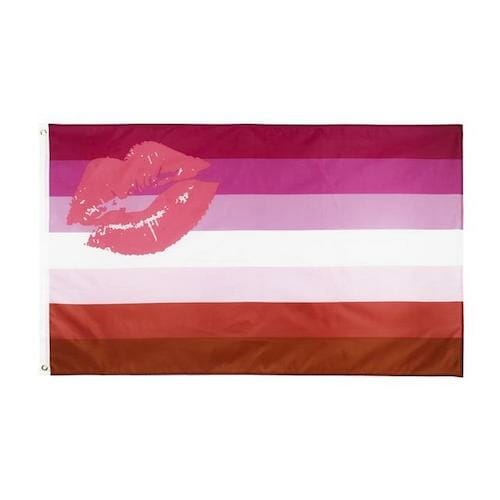
Maverique Pride Flag
Maverique is a nonbinary or abinary gender that has a significant gendered experience but is neither male nor female. It is not a lack of gender. It is defined by autonomy and inner conviction about a notion of gender that is unusual, atypical, and exists independently of standard gender conceptions.
Maverique persons (like people of any gender) are free to use whichever pronouns they like and to present themselves in whatever way they want.
Like many LGBTQ+ flags, the maverique pride flag was first created on Tumblr, by Vesper H. (queerascat), who also coined the term maverique a few days earlier. The following are the meanings of the colors:
- Yellow, which denotes the agender, is the primary color used, meaning it is distinct from the other basic hues, just like maverique is distinct from masculinity and femininity. Non-binary gender is frequently related to the color yellow.
- White signifies autonomy and independence from both the gender binary and the color spectrum. White is the gender-neutral canvas on which maverique is built.
- Orange symbolizes a fiery inner conviction as well as their unconventional and unique personality.

Neutrois Pride Flag
Neutrois is a gender identity that refers to gender neutrality, or neutral gender. It is typically interpreted as indifference to gender or even its absence (nullity), as in agender.
The exact distinction between terminology like agender and neutrois is a point of contention. Some people use these phrases interchangeably; however, there is a distinction between them for others. One of the most commonly mentioned distinctions is that agender is the sense of having no gender at all, while neutrois is the feeling of having a gender identity that is neither male nor female but rather neutral.
The colors of the neutrois pride flag have the following meanings:
- White denotes being gender-neutral, unidentified, or undecided.
- Dark chartreuse green is the opposite of lavender, a blend of pink and blue, indicating that it is neither female nor male.
- Black is associated with being agender or genderless.

Non-Binary Pride Flag
While the term "nonbinary" or "enby" can mean different things to different people, it is typically used to describe someone whose gender identity isn't exclusively male or female.
Kye Rowan created the Non-Binary Pride Flag in 2014 to be flown alongside the genderqueer flag – not to replace it. The flag has yellow, white, purple, and black horizontal stripes. This flag represents non-binary people who don't feel represented by the genderqueer flag.
Taken together, these four colors of the flag aim to include and specifically depict the experience of non-binary people. Non-binary people worldwide have embraced Rowan's design, and today you can see the flag being carried at Pride parades around the world. The four colors of the non-binary flag stand for:
- Yellow stands for people whose gender doesn't exist within the binary.
- White represents people with all genders or many genders.
- Purple stands for people with genders that may be a mix of female and male.
- Black represents people that identify as not having any gender at all.
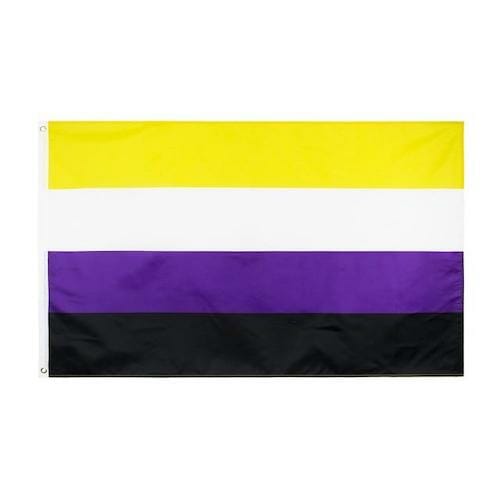
Omnisexual Pride Flag
An omnisexual is a person who has romantic, sexual, or affectional desires for people of all genders and sexes. This is similar to pansexuality; however, there are differences between these two terms. Omnisexual people are not gender blind, and they see and acknowledge gender. Omnisexual people are sexually attracted to different genders and sexual orientations, but unlike pansexuality, the gender of the people they are attracted to matters to some degree.
Like most queer identities, omnisexuals have an exclusive LGBTQ+ flag that they fly which includes shades of pink, purple, and blue. The omnisexual pride flag was created by @pastelmemer in 2015; however, they never explained the exact meaning of the colors.
That has not stopped many omnisexual individuals from putting their feelings to each color, and the current semi-consensus to what these colors mean is:
- Pink stands for attraction to women.
- Blue stands for attraction to men.
- Purple stands for attraction to non-binary people.
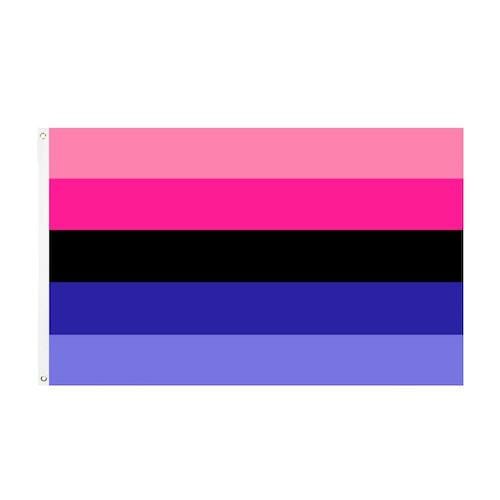
Original Gilbert Baker Rainbow Pride Flag
On June 25th, 1978, the first gay pride flags were flown at the San Francisco Gay Freedom Day Parade. Until this point, the pink triangle had been used as a symbol for the LGBT community – despite its relation to an exceptionally dark chapter in the history of homosexuality.
The flag was created by Gilbert Baker—an activist, drag queen, and artist—who described his rainbow-striped design as "something beautiful, something from us… it really fits our diversity in terms of race, gender, ages, all of those things."
The same day during the parade, two pride banners replaced the United States and United Nations flags hoisted at the United Nations Plaza in San Fran, and the world saw the first LGBQ+ flags.
The different colors of this flag were often associated with "diversity" in the gay community (but actually have literal meanings), including:
- Red for life.
- Orange for healing.
- Yellow for sunlight.
- Green for nature.
- Blue for harmony/peace.
- Purple for spirit.
- Pink for sexuality.
- Turquoise for art/magic.
Pink and turquoise were removed for production purposes, and the six-band variant, now simply known as the "Gay pride" flag, has been the most well-recognized symbol of the LGBT movement since 1979. It has been built on for them at various times, including with the addition of black-and-brown for people of color in 2017 for the Philadelphia Pride Flag, and white-pink-blue for transgender and queer people in 2018 for the Pride Progress flag.
The original LGBTQ+ flag, a segment of the original Gilbert Baker rainbow flag, was recently rediscovered and donated to San Fransisco's GLBT Historical Society Museum and Archives.
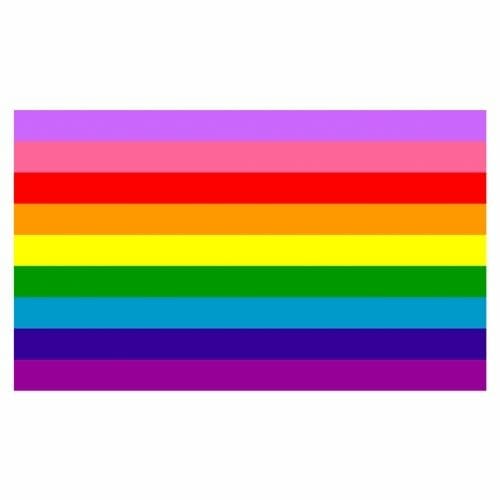
Pangender Pride Flag
Pangender is someone who feels comfortable with different kinds of gender labels and whose gender identity is not limited to one gender and may encompass all genders at once. It comes with an understanding that the vast and diverse multiplicity of genders within the same individual can extend infinitely, always within the person's own culture and life experience, and may or may not include unknown genders.
Cari Rez Lobo first proposed the Pangender Pride flag in 2015 on Tumblr. The suggested pride flags for the Pangender Spectrum are based on the agender pride flag. The colors are extremely vibrant (like the brightness has been turned up) to symbolize the diversity of genders as white light, in the electromagnetic spectrum, is a combination of all colors.
The other color of the pangender pride flag also have meaning:
- Yellow is for all genders that aren't connected to female and male and are represented by the yellow color.
- Light red color denotes the transition between the genders of female and male.
- Light violet-pink represents female and male.
- White symbolizes the union of all of these genders.
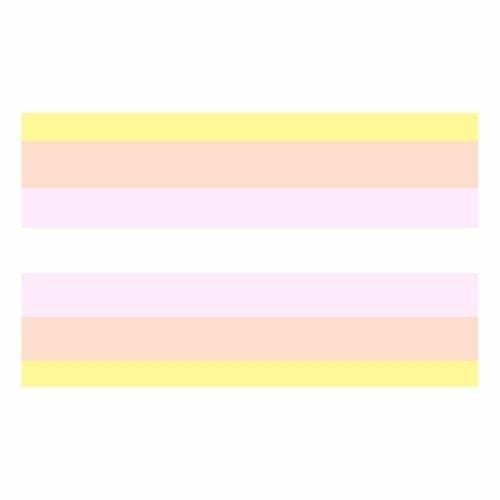
Pansexual Pride Flag
A pansexual is not limited in sexual choice concerning biological sex, gender, or gender identity. They will often refer to themselves as gender-blind, explaining that gender and sex do not determine their romantic or sexual attraction to others.
The pansexual pride flag was created by an online pansexual community in 2010. It represents the differences between pansexual and bisexual identities since there is common confusion between these communities.
The pansexual flag has three distinct stripes. The top one is salmon pink, the next one is canary yellow, and the bottom one is bright blue. These three colors represent the different gender groups that pansexual individuals may be attracted to and so:
- Pink represents those who identify as female.
- Blue represents tools that identify as male.
- Yellow represents individuals that identify anywhere in the gender spectrum or beyond.
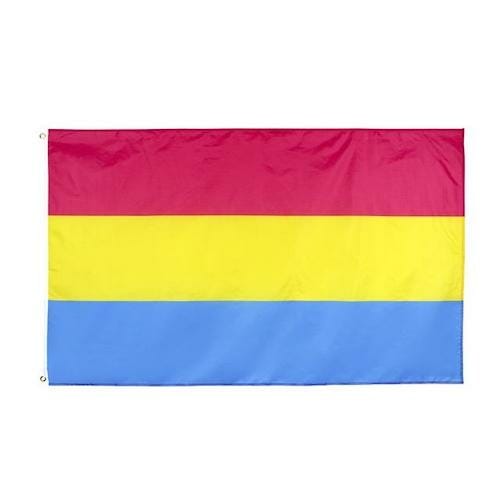
Philadelphia Pride Flag
The city of Philadelphia approved a redesigned version of the flag created by the marketing agency Tierney in June 2017, which adds black and brown stripes to the top of the traditional six-color flag to call attention to concerns affecting LGBT people of color. It was introduced as part of a citywide "More Color More Pride" campaign — and was borne of protest after several high-profile stories exposing racism in Philly's Gayborhood.
It was rapidly adopted around the world and gave representation to black and brown people in the LGBTQ community and their experiences. It is still frequently used; however, it has been built upon to be more inclusive of the transgender community just a few years later with the Pride Progress Flag.
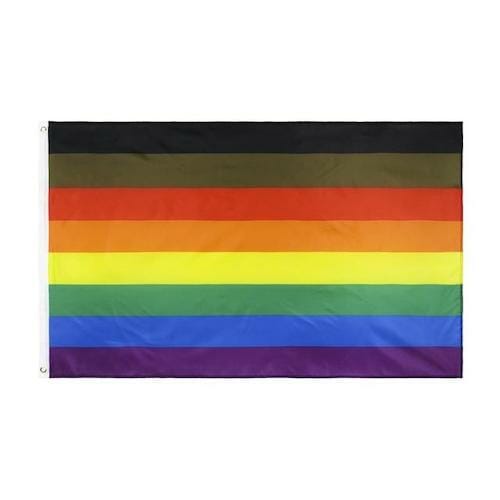
Polyamory Pride Flag
A polyamorous person desires or engages in multiple romantic (and typically sexual) relationships with the consent of all the people involved.
Jim Evans created the original polyamory pride flag in 1995. The flag has blue, red, and black bars with the Greek letter pi symbol in the middle. The blue bar represents honesty and openness among partners, while the red bar represents love and affection.
The black bar represents solidarity with all people that have to hide their multi-lover partnerships from the rest of the world. There are many explanations for the pi symbol in the middle of the flag. However, the one that makes the most sense and is agreed upon but most people is that it stands for infinite love amongst partners.
Much like other LGBTQ+ flags, there have been many variations of the polyamorous flag after various community members decided that the original flag was undesirable. Some of the variations include the removal of the pi symbol and replacing it with an infinity heart symbol. The infinite heart symbol has been a recurring aspect of variations of the polyamorous flag – but this original flag is still the most agreed upon and commonly seen.
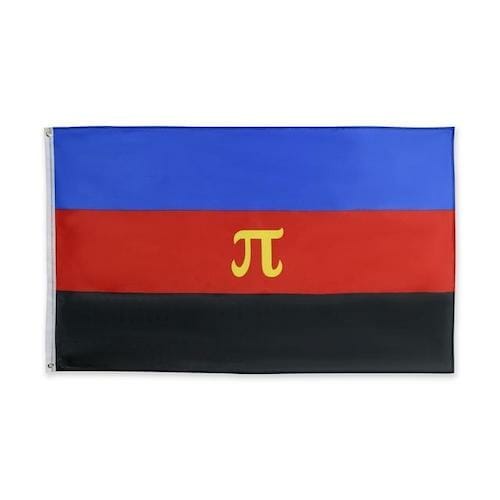
Polysexual Pride Flag
A polysexual person is someone who is sexually and/or romantically attracted to multiple genders. Sometimes, polysexuality is likened to other multi-sexual identities. One of the main differences between pansexual and omnisexual is that people who identify with these terms are attracted to all genders. On the other hand, a polysexual may not necessarily be attracted to all genders but may be attracted to many genders.
The polysexual pride flag has pink, green, and blue stripes. Pink represents an attraction to women, green represents an attraction to non-binary people, and blue represents an attraction to men. The polysexual flag was created by Tumblr user Tomlin in 2012. The user created the flag after noting that polysexuals did not have a flag to represent them. He made the flag similar to pan and bi flags since all these identities are under the multisexual umbrella.
An anonymous wiki user designed an alternative poly flag on October 21st, 2020. This new design is meant to be easier on the eyes while maintaining the same meaning. This flag still has the original stripe colors with their meaning, and the additional lighter pink and blue stripes stand for poly individuals. The light green almost white stripes represent peace, poly, and transgender individuals.
For now, the original polysexual pride flag is the most frequently seen, but in the future, this could evolve. Remember that many LGBTQ+ pride flags have multiple versions in use simultaneously. It doesn't make them less valid.
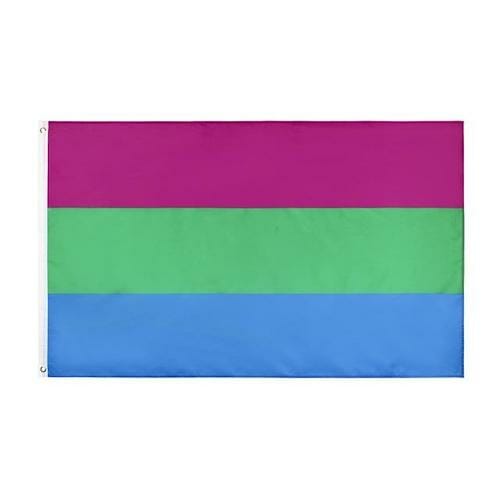
Puppy Pride Flag
Puppy (or pup) play is a type of role-play behavior in which adult humans adopt the characteristics of dogs (puppies, in particular) and is popular in the gay leather community. It is, however, not an exclusively gay kink, and can be considered under the wider BDSM umbrella.
The puppy pride flag denotes a member of the Pet Play community. It's a quasi-derivative of the leather flag, but with a red bone in the center and an angle. The white stripe is somewhat larger to reflect the community's diversity, while the bone represents the puppy's loving, nonjudgmental heart.
There are various other Pup Pride Flags, including those with a Doberman instead of the bone, but this is the most widely used now.
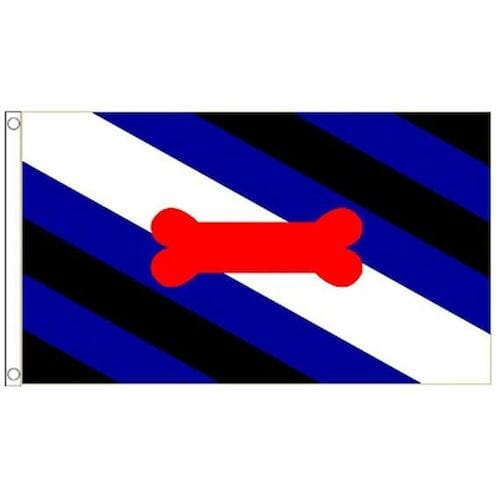
Queer Pride Flag
Queer is an identity in and of itself that more and more people are choosing to identify with. It is a sort of label for those who don't want to put themselves in a box. Often considered a movement, queer people are those who fall outside of and/or renounce the cultural norms around sexuality, gender identity, and/or gender expression.
The word queer can mean different things to different people, but the most accepted definition is someone who is not cishet or someone with variant experiences with orientation, gender, and/or sex.
One of the first flags created explicitly as the "queer flag" was designed by Pastelmemer in 2015. There are not many alternative flags but this still the most popular. On this flag:
- The shades of pink next to each other and shades of blue next to each other symbolize same-gender attraction.
- The orange and green are for non-binary individuals.
- Black and white are for asexual, aromantic, and agender spectrum individuals.
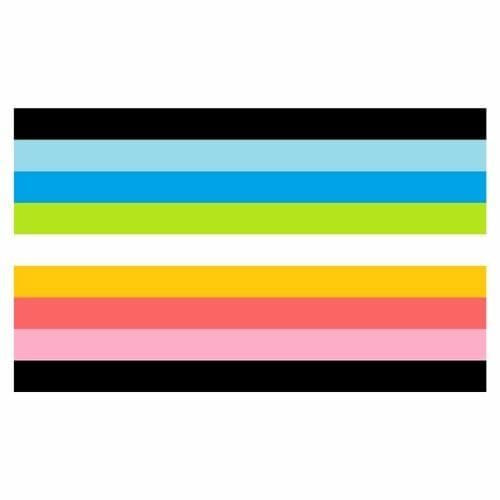
Questioning Pride Flag
Questioning is the act of figuring out what one's gender, sexual orientation, romantic orientation, or any aspect of one's identity is by investigating, educating, or exploring with it.
There are many questioning pride flags, but most have some form of question mark incorporated into the design. The version created by Swocks, the owner of a large LGBTQ+ Hangout community, was first used on August 18th, 2020, and is now the most frequently seen with a pastel flag with the white question mark over it represents questioning pride.
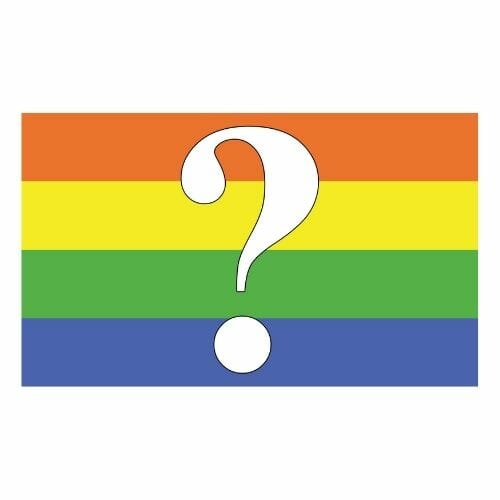
Rubber Pride Flag
Like many other kink communities, the rubber/latex fetish community members have a flag to express their preferences and passion. While popular with gay men and often seen at pride parades, rubber pride is not exclusive to any gender or sexuality.
It was created by Peter Tolos and Scott in 1995, who have said that:
- Black represents the lust for the look and feel of shiny black rubber.
- Red represents the blood passion for rubber and rubbermen.
- Yellow represents the drive for intense rubber play and fantasies.
Oh, and there is also a literal kink in the design of the rubber pride flag, which totally makes sense!
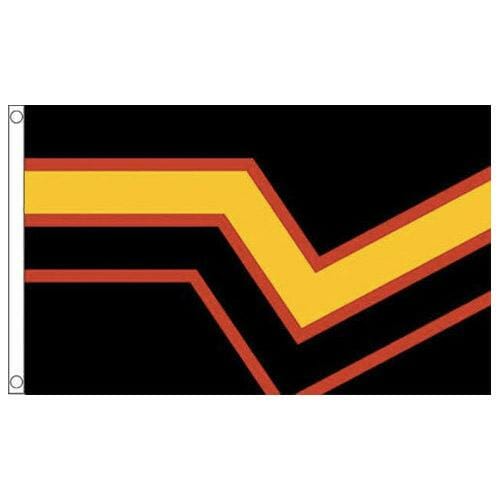
Straight Ally Pride Flag
A straight ally is a cisgender or heterosexual person who recognizes the discrimination faced by the LGBTQ community due to their gender identity, expression, or sexual orientation. They are not themselves part of the queer rainbow family but support LGBTQ+ causes and fight for a more inclusive world.
Sadly, it isn't known who made or designed the straight ally flag. However, what is known about it is that it was first used in the 2000s. The straight ally flag was created by combining the LGBTQ pride flag and the straight flag.
The straight ally flag doesn't have the original LGBTQ pride flag colors made by Baker. This flag only uses the more modern six-colored flag without pink and turquoise. The straight ally flag represents unity and support towards the LGBTQ community.
Here's what the straight ally flag means:
- The letter 'A' means ally.
- The black and white stripes represent the straight flag.
- The rainbow colors in the letter 'A' are for the LGBT community.
Keep in mind that bearing this flag is not a trend. It comes with an understanding of the challenges that LGBTQ people face and knowing that you're responsible for doing something about them.
In addition, just because there's a straight ally flag doesn't mean that brandishing the flag is a requirement for supporting the LGBTQ community. As a true ally, you will give your support in many different ways.
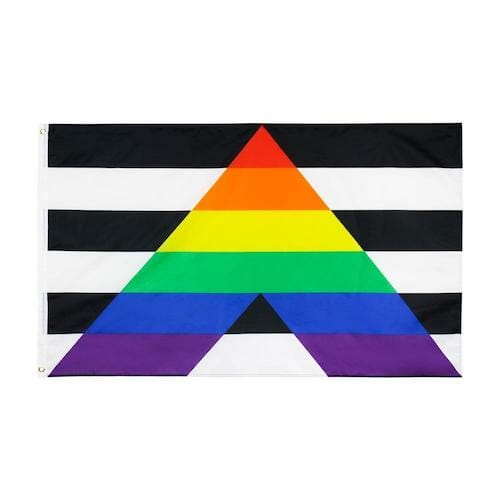
Transgender Pride Flag
A transgender person is someone whose gender identity is different from the gender they were thought to be at birth.
Monica Helms, a transgender woman, and navy veteran, created the transgender flag in 1999. She said that the idea for the transgender flag came to her early one morning.
"When you wake up, and you're still sort of groggy and everything but you're starting to think, and your mind is starting to fill with images — that's when it came to me," she said – every much a case of "divine intervention."
She brought the first transgender flag to the 2000 Phoenix Pride Parade. The Smithsonian's National Museum of American History in Washington DC later acquired the flag in 2014.
When Monica brought the flag to the pride parade in Phoenix, many people were interested in her design. People saw it, liked it, and also thought that she had excellent reasons for the colors. After that, the flag took off.
The transgender flag has light blue, pink, and white stripes. According to Monica, here's what the colors mean:
- Light blue represents boys.
- Pink represents girls.
- The middle white color is for those who are transitioning, intersex people, and those who feel they have no gender or have a neutral gender like non-binary, genderqueer or genderfluid individuals.
"The pattern is such that no matter which way you fly it, it is always correct, signifying us finding correctness in our lives," Monica said.
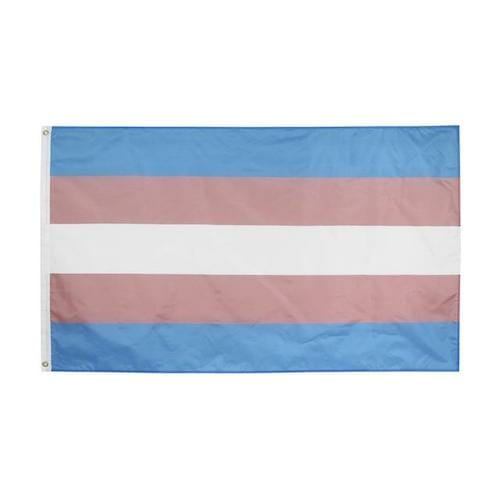
Trigender Pride Flag
Trigender is a gender identity in which a person switches between or among several genders, including a third gender (genderless, a mix of masculine and feminine, or any other variety of genderqueer identities). Dependent on the individual's mood or environment, a trigender individual may change from one gender to another.
An unknown person developed the trigender flag, and the first known use was on July 4th, 2015. The trigender pride flag has five stripes and three colors which stand for:
- Pink signifies femininity and female genders.
- Blue signifies masculinity and male genders.
- Green signifies androgyny and third/other genders.
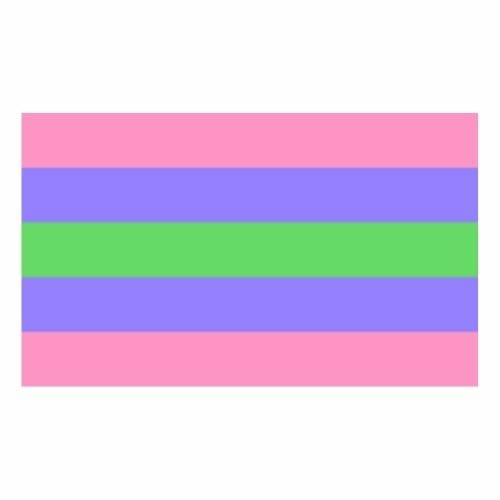
Twink Pride Flag
Twinks are a subset of gay males that challenge traditional masculinity by adopting gendered and feminine characteristics. Physical appearance, preferences, display of traditionally gendered characteristics, and personal connection may all be used to describe twinks.
A twink is often shown as a skinny guy with no facial hair and often no body hair, who may or may not dress in non-traditionally masculine ways.
The three equal-width stripes on the twink pride flag are pale pink at the top and pale yellow at the bottom. The interwoven pair of Mars symbols on the middle white stripe is widely used to signify homosexual males. These colors were adopted for their "soft" look, with pink representing femininity and yellow representing independence.
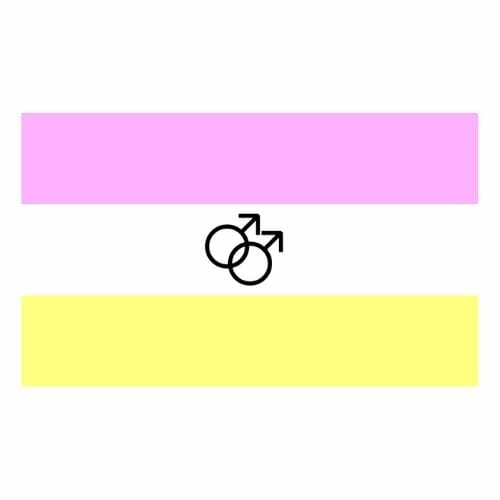
Two-Spirit Pride Flag
Two-Spirit, also known as Two-Spirited, is an Indigenous North American identity that encompasses sexuality, gender, and/or spirituality. Two-Spirit is a broad concept that embraces homosexual/homoromantic affinity as well as a wide range of gender diversity, including those who are gay, lesbian, bi, trans, genderqueer, GNC, or have multiple gender identities in Western society.
There is no one agreed-upon two-spirit flag; however, tumbler user 2Sanon developed the most commonly seen two-spirit flag. They submitted it to ask-pride-color-schemes on December 17th, 2016. The circle denotes oneness in one, while the two feathers signify woman and man. It's usually put over the LGBT rainbow flag, but it may also be draped over a transgender or nonbinary flag.
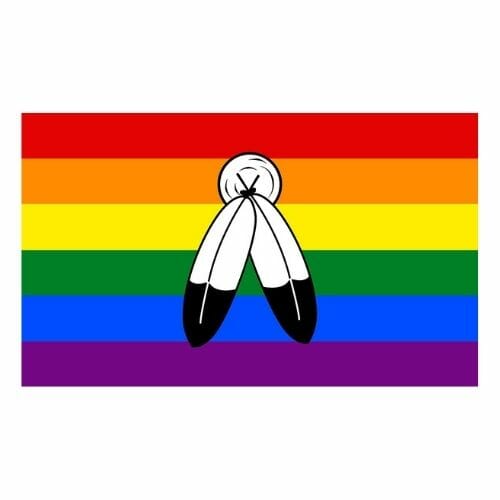
Other Popular LGBTQ Flags
Born This Way Pride Flag
If you were 'Born This Way,' in the emotive words of the fantastically extravagant Lady GaGa, then this flag is for you!
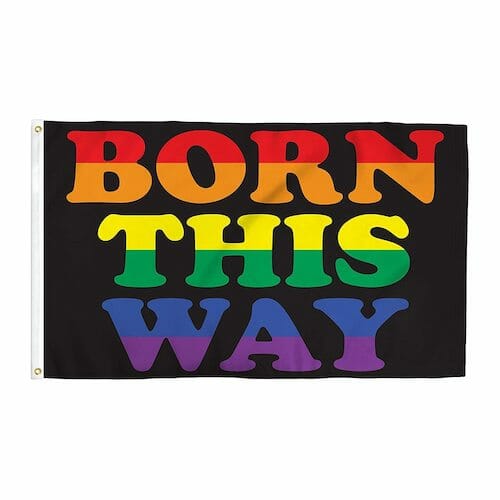
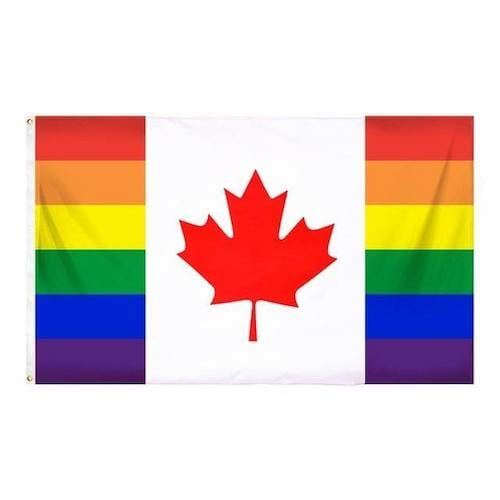
Equal Human Rights Pride Flag
Proudly show your support for LGBTQ+ equality with this Equality Flag, featuring the Human Rights Campaigns' iconic equal sign logo in blue and yellow.
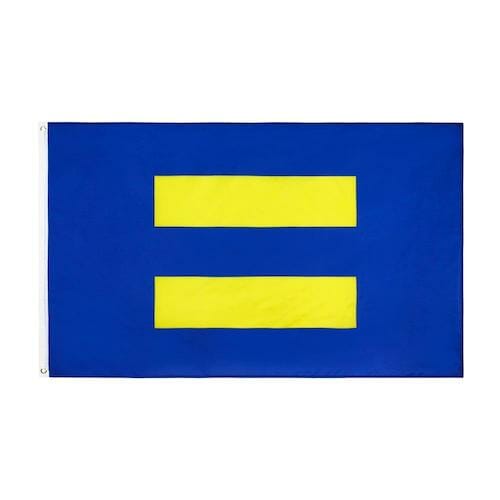

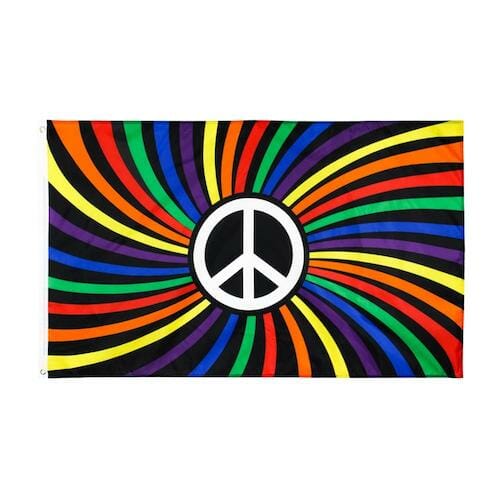
HUMAN LGBT Pride Flag
A popular queer flag that has Human spelled out with other LGBTQ flag colors behind the letters.
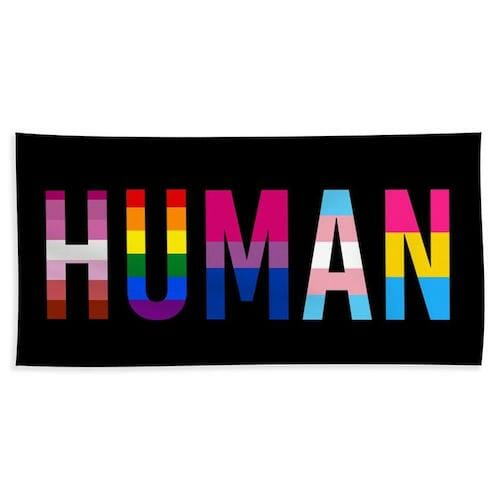
Kindness Is Everything Pride Flag
An LGBTQ flag that proclaims kindness is everything. Black Lives Matter. Women's rights. Love is Love. Science Is Real. No Human Is Illegal. Are Human Rights. Enough said really.

LGBT Pride Flag
An LGBTQ flag that proclaims pride with the iconic rainbow colors showing on a black background.
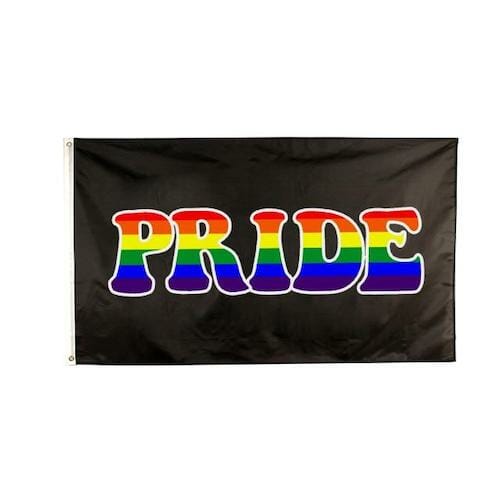
USA Gay Pride Flag
The standard 6 stripe rainbow LGBT flag crossed with the American flag.
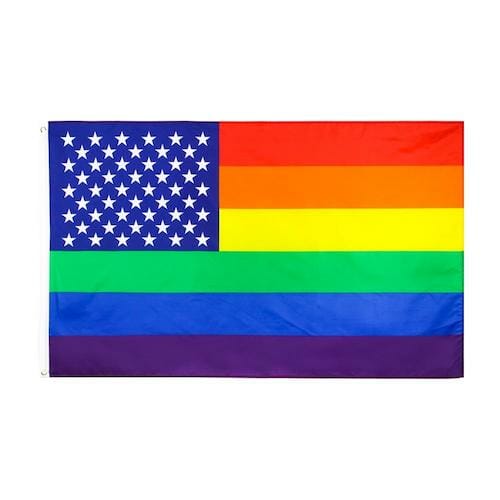

collinssuposincer.blogspot.com
Source: https://queerintheworld.com/different-lgbtq-flags-and-meaning/
0 Response to "Tan Girl Green Clothes White Girl Blue Dress Lesbians"
Post a Comment